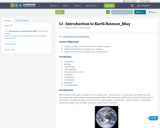
Draft of 1.1
- Subject:
- Applied Science
- Material Type:
- Activity/Lab
- Date Added:
- 05/31/2018

Draft of 1.1
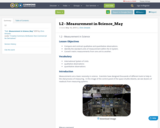
1.2

Twelve Stones portrays the heart of Heifer's work - Passing on the Gift ÂŽ - and shows the transformation of a community of women in Nepal from helplessness to hope through Heifer International. This is a preview clip of a documentary produced by Sandy Smolen.

Learn how important the honey bee's body structure is to survival in the hive. This lesson includes learning objectives, material and resource lists, background information, activities, reading selections, writing assignments, a game, assessments, and support documents. See the Educator's Guide for more video links and recommended readings.

Learn how important the honey bee's body structure is to survival in the hive. This lesson includes learning objectives, material and resource lists, background information, activities, reading selections, writing assignments, a game, assessments, and support documents. See the Educator's Guide for more video links and recommended readings.
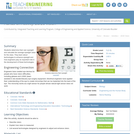
In this activity, students determine their own eyesight and calculate what a good average eyesight value for the class would be. Students learn about technologies to enhance eyesight and how engineers play an important role in the development of these technologies.

This lesson will allow students to select and share what details are important on a topic. Groups of students will research a topic and then discuss and determine the top 25 important things someone should know about the topic.

Learn the importance of each and every job within the hive! This lesson includes learning objectives, material and resource lists, background information, activities, reading selections, writing assignments, a game, assessments, and support documents. See the Educator's Guide for more video links and recommended readings.
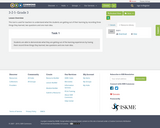
This tool is used for teachers to understand what the students are getting out of their learning by recording three things they learned, two questions and one main idea.
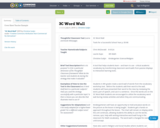
Cover Sheet
Teacher Example
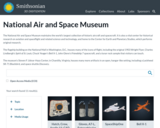
3D Scans of Museum artifacts

This comprehensive Open Source lesson plan is designed for Kindergarten through Middle School level students to learn about life cycles, plants needs, and plant structures & their functions through hands-on investigations with Wisconsin Fast Plants. Depending on the grade level, students engage at an appropriate depth with developing models and constructing arguments that plants have internal and external structures that function to support survival, growth, behavior, and reproduction. This lesson is available as a Google Doc in the Gather, Reason, Communicate instructional model. You may copy the lesson Doc to your own Drive and edit/adapt for your own use--it is shared by the Fast Plants Program as an Open Education Resource" therefore, you are free to use and adapt for noncommercial purposes, provided you attribute the Wisconsin Fast Plants Programs website (www.fastplants.org) as your source and share openly (for noncommercial purposes) any materials you develop with ours.

This resource was created by Judy Prewett, in collaboration with Dawn DeTurk, Hannah Blomstedt, and Julie Albrecht, as part of ESU2's Integrating the Arts project. This project is a four year initiative focused on integrating arts into the core curriculum through teacher education, practice, and coaching.
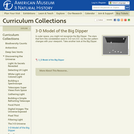
Students see firsthand that stars and constellations are not arranged in a flat, 2-D pattern in this Moveable Museum unit. The five-page PDF guide includes suggested general background readings for educators, activity notes, step-by-step directions, and a Big Dipper map. Students make their own 3-D models of the Big Dipper using readily available materials and examine their models, observing the 3-D constellation from new perspectives.

Children creat a 3 dimensional model of various constellations to learn how 2d images are actually 3d.

Learn how honey bees work together as a hive to provide for their own needs while pollinating our planet's flowers! This lesson includes learning objectives, material and resource lists, background information, activities, reading selections, writing assignments, a game, assessments, and support documents. See the Educator's Guide for more video links and recommended readings.
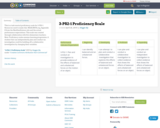
This is a task neutral proficiency scale for 3-PS2-1. Resources used to make this: NGSS.NSTA.org, Appendix E from the NextGenScience site and the actual performance expectations. This scale was created through collaboration with five elementary teachers.
Note: Proficiency scales assume learning progression. A student that can independently plan and conduct an investigation could be building off a collaborative investigation by changing their variables.

In this lesson, students expand their understanding of solid waste management to include the idea of 3RC (reduce, reuse, recycle and compost). They will look at the effects of packaging decisions (reducing) and learn about engineering advancements in packaging materials and solid waste management. Also, they will observe biodegradation in a model landfill (composting).

The attached lesson plan is designed for 3rd grade English Language Arts students. Students will analyze informational text to determine the main ideas for a report, apply the concepts of the writing process, and communicate their research through an oral presentation to their classroom peers. This lesson plan addresses the following NDE Standards: NE LA 3.1.6.e, NE LA 3.2.1.a,c,d,e,j, NE LA 3.3.1.aIt is expected that this lesson plan will take five one-hour sessions to complete.
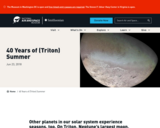
On Triton, Neptune's largest moon, seasons last an average of 40 years, complete with nitrogen snow. Here's how Triton's summer solstice compares to Earth's.